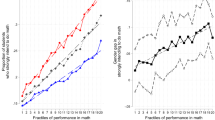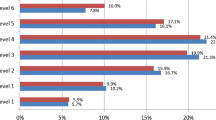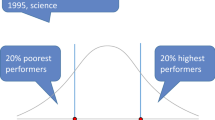Abstract
This study examined a new form of pervasive gender inequality: the gender gap among high achievers in math and considered its implication for developing STEM talents. Using the cross-nation Programme for International Student Achievement (PISA) data from both 2003 and 2012, we examined the mathematics gender gap among 15-year-old high achievers across ten countries/regions. We showed a consistent male advantage among the top performers in mathematics. Follow-up regression analyses revealed that the gap was associated with some socio-demographic and schooling/attitudinal variables, even after controlling for the background variables. We argue that education communities should acknowledge and address this form of gender inequality, as it could have ramifications for the science, technology, engineering, and mathematics (STEM) education pipeline. Educators and society in general still face challenges in closing the gender gap among high achievers in math with an aim to develop a gender-balanced STEM talent pool.



Similar content being viewed by others
Notes
As of this writing, PISA 2015 data have just become available. Because PISA 2015 assessment did not have mathematics as the main assessment, but had science as the main assessment instead, for the reasons explained in the text, we decided not to analyze 2015 PISA data for our study.
The effect size is the standardized mean difference in math performance, as represented by Cohen’s d \(\left( {d = \frac{{Mean_{male} - Mean_{female} }}{{S_{pooled} }}} \right)\). Five effect sizes were calculated based on five plausible values, and then we took the average of these five.
For simplicity, we did not present inferential statistics of the ratio estimates in the figure. We did compute the 95% confidence interval for all the ratio estimates. The method and results are enclosed in the Appendix. Nine out of ten countries/regions have statistically significant male-to-female ratios higher than 1, with the United States being the exception.
Proficiency level is OECD’s way of categorizing student performance. Proficiency level ranges from the lowest level 1 to highest level 6. Only 3.3 percent of OECD students achieved level 6 in mathematics in 2012. For details, see OECD (2014a, p. 61).
Detailed information about the ORs of the background variables is available upon request from the corresponding author.
To account for design effect of complex sampling, we applied statistical weights at both the student and school level. The weights were scaled using a method proposed by Pfeffermann et al. (1998).
References
Bandura, A. (1997). Self-efficacy: The exercise of control. NY: W.H. Freeman and Company.
Bandura, A., Barbaranelli, C., Caprara, G. V., & Pastorelli, C. (1996). Multifaceted impact of self-efficacy beliefs on academic functioning. Child Development, 67(3), 1206–1222.
Benight, C. C., & Bandura, A. (2004). Social cognitive theory of post-traumatic recovery: The role of perceived self-efficacy. Behaviour Research and Therapy, 42(10), 1129–1148.
Betz, N. E., & Hackett, G. (1986). Applications of self-efficacy theory to understanding career choice behavior. Journal of Social and Clinical Psychology, 4(3), 279–289.
Brauner, P., Leonhardt, T., Ziefle, M., and Schroeder, U. (2010). The effect of tangible artifacts, gender and subjective technical competence on teaching programming to seventh graders. In Proceedings of the 4th International Conference on Informatics in Secondary Schools (ISSEP 2010) (LNCS, Vol. 5941, pp. 61–71).
Casella, G., & Berger, R. L. (2002). Statistical inference (2nd ed.). Pacific Grove, CA: Duxbury.
Ceci, S. J., & Williams, W. M. (2011). Understanding current causes of women’s underrepresentation in science. Proceedings of the National Academy of Sciences, 108(8), 3157–3162.
Chen, D., & Kelly, H. (2013). Understanding the leaky STEM pipeline by taking a closer look at factors influencing retention and graduation rates. Institutional Research, University of Delaware.
Department of Commerce. (2011). Women in stem: A gender gap to innovation. U.S. Department of Commerce. http://www.esa.doc.gov/reports/women-stem-gender-gap-innovation.
Department of Education and Training. (2014). Restoring the focus on STEM in schools initiative. Department of Education and Training of Australian Government.
Fan, X., Chen, M., & Matsumoto, A. R. (1997). Gender differences in mathematics achievement: Findings from the National Education Longitudinal Study of 1988. The Journal of Experimental Education, 35(3), 229–242. doi:10.1080/00220973.1997.9943456.
Geary, D. C. (2011). Cognitive predictors of achievement growth in mathematics: A 5-year longitudinal study. Developmental Psychology, 47(6), 1539–1552.
Guiso, L., Monte, F., Sapienza, P., & Zingales, L. (2008). Culture, gender, and math. Science, 320(5880), 1164–1165. doi:10.1126/science.1154094.
Halpern, D. F., Benbow, C. P., Geary, D. C., Gur, R. C., Hyde, J. S., & Gernsbacher, M. A. (2007). The science of sex differences in science and mathematics. Psychological Science in the Public Interest, 8(1), 1–51. doi:10.1111/j.1529-1006.2007.00032.x.
Hyde, J. S. (2005). The gender similarities hypothesis. American Psychologist, 60(6), 581–592. doi:10.1037/0003-066X.60.6.581.
Hyde, J. S., Lindberg, S. M., Linn, M. C., Ellis, A. B., & Williams, C. C. (2008). Gender similarities characterize math performance. Science, 321(5888), 494–495. doi:10.1126/science.1160364.
Hyde, J. S., & Mertz, J. E. (2009). Gender, culture, and mathematics performance. Proceedings of the National Academy of Sciences, 106(22), 8801–8807. doi:10.1073/pnas.0901265106.
Langenfeld, T. E. (1997). Test fairness: Internal and external investigations of gender bias in mathematics testing. Educational Measurement, 16(1), 20–26. doi:10.1111/j.1745-3992.1997.tb00582.x.
Li, Q. (1999). Teachers’ beliefs and gender differences in mathematics: A review. Educational Research, 41(1), 63–76. doi:10.1080/0013188990410106.
Lindberg, S. M., Hyde, J. S., Petersen, J. L., & Linn, M. C. (2010). New trends in gender and mathematics performance: A meta-analysis. Psychological bulletin, 136(6), 1123–1135
Liu, O. L., & Wilson, M. (2009). Gender differences and similarities in PISA 2003 mathematics: A comparison between the United States and Hong Kong. International Journal of Testing, 9(1), 20–40. doi:10.1080/15305050902733547.
Machin, S., & Pekkarinen, T. (2008). Global sex differences in test score variability. Science, 322(5906), 1331–1332. doi:10.1126/science.1162573.
Mullis, I. V., Martin, M. O., Fierros, E. G., Goldberg, A. L., Stemler, S. E. (2000). Gender differences in achievement: IEA’s third international mathematics and science study (TIMSS). International Association for the Evaluation of Educational Achievement. http://timssandpirls.bc.edu/timss1995i/TIMSSPDF/t95_gender_all.pdf.
Mullis, I. V., Martin, M. O., & Foy, P. (2005). IEA’s TIMSS 2003 international report on achievement in the mathematics cognitive domains. Chestnut Hill, MA: Lynch School of Education, Boston College. http://timssandpirls.bc.edu/timss2003i/mcgdm.html.
National Center for Education Statistics. (2002). Digest of education statistics: 2001. Washington, DC: Author. http://nces.ed.gov/pubsearch/pubsinfo.asp?pubid=2002130.
National Center for Education Statistics. (2005). Digest of education statistics, 2005. Washington, DC: Author. http://nces.ed.gov/pubsearch/pubsinfo.asp?pubid=2006030.
National Science Foundation. (2008). Science and engineering indicators 2008. National Science Foundation. http://www.nsf.gov/statistics/seind08/.
New York Hall of Science. (2012). Design-make-play: Growing the next generation of science innovators. Author.
OECD. (2003). The PISA 2003 assessment framework: Mathematics, reading, science and problem solving knowledge and skills. Paris: OECD Publishing.
OECD. (2004). Learning for tomorrow’s world: First results from PISA 2003. Paris: OECD Publishing.
OECD. (2009). PISA data analysis manual: SPSS (2nd ed.). Paris: OECD Publishing.
OECD. (2013). PISA 2012 assessment and analytical framework: Mathematics, reading, science, problem solving and financial literacy. Paris: OECD Publishing. doi:10.1787/9789264190511-en.
OECD. (2014a). PISA 2012 results: What students know and can do—student performance in mathematics, reading and science (Revised edition ed., Vol. 1). Paris: OECD Publishing. doi:10.1787/9789264201118-en.
OECD. (2014b). PISA 2012 technical report. Paris: OECD Publishing. http://www.oecd.org/pisa/pisaproducts/pisa2012technicalreport.htm.
Pajares, F. (1996). Self-efficacy beliefs in academic settings. Review of Educational Research, 66, 543–578. doi:10.3102/00346543066004543.
Pajares, F. (2002). Self-efficacy beliefs in academic contexts: An outline.” Retrieved June 26, 2017, from http://des.emory.edu/mfp/efftalk.html.
Pajares, F., & Margaret, J. J. (1994). Confidence and competence in writing: The role of self-efficacy, outcome expectancy, and apprehension. Research in the Teaching of English, 28, 313–331.
Parker, P. D., Marsh, H. W., Ciarrochi, J., Marshall, S., & Abduljabbar, A. S. (2014). Juxtaposing math self-efficacy and self-concept as predictors of long-term achievement outcomes. Educational Psychology, 34(1), 29–48.
Penner, A. M. (2008). Gender differences in extreme mathematical achievement: An inter- national perspective on biological and social factors. American Journal of Sociology, 114(S1), S138–S170.
Penner, A. M., & Paret, M. (2008). Gender differences in mathematics achievement: Exploring the early grades and the extremes. Social Science Research, 37(1), 239–253
Pfeffermann, D., Skinner, C. J., Holmes, D. J., Goldstein, H., & Rasbash, J. (1998). Weighting for unequal selection probabilities in multilevel models. Journal of the Royal Statistical Society Series B, 60(1), 23–40.
Rohde, T. E., & Thompson, L. A. (2007). Predicting academic achievement with cognitive ability. Intelligence, 35(1), 83–92.
Rubin, D. B. (1987). Multiple imputation for nonresponse in surveys. Hoboken: Wiley.
Rutkowski, L., Gonzalez, E., Joncas, M., & von Davier, M. (2010). International large-scale assessment data: Issues in secondary analysis and reporting. Educational Researcher, 39(2), 142–151. doi:10.3102/0013189X10363170.
Sadler, P. M., & Tai, R. H. (2007). The two high-school pillars supporting college science. Science, 317(5837), 457–458. doi:10.1126/science.1144214.
Sass, T. R. (2015). Understanding the STEM pipeline (Working Paper No. 125). National Center for Analysis of Longitudinal Data in Education Research.
Schafer, J. L., & Olsen, M. K. (1998). Multiple imputation for multivariate missing-data problems: A data analyst’s perspective. Multivariate Behavioral Research, 33(4), 545–571. doi:10.1207/s15327906mbr3304_5.
Shoemaker, D. M. (1973). Principles and procedures of multiple matrix sampling. Oxford: Ballinger.
Stoet, G., & Geary, D. C. (2013). Sex differences in mathematics and reading achievement are inversely related: Within- and across-nation assessment of 10 years of PISA Data. PLoS ONE, 8(3), e57988. doi:10.1371/journal.pone.0057988.
Stoet, G., & Geary, D. C. (2015). Sex differences in academic achievement are not related to political, economic, or social equality. Intelligence, 48, 137–151.
The Education Bureau. (2016). Promotion of stem education: Unleashing potentials in innovation. Hong Kong: The Education Bureau of Hong Kong.
von Davier, M., Gonzalez, E., & Mislevy, R. J. (2009). What are plausible values and why are they useful? In M. von Davier & D. Hastedt (Eds.), (Vol. 2, pp. 9–36). Princeton, NJ: IEA-ETS Research Institute.
Wang, X. (2013). Why students choose stem majors: Motivation, high school learning, and postsecondary context of support. American Educational Research Journal, 50(5), 1081–1121.
World Economic Forum. (2015). The global gender gap report. http://reports.weforum.org/global-gender-gap-report-2014/part-1/the-global-gender-gap-index-results-in-2014/country-results/.
Wooldridge, J. M. (2010). Econometric analysis of cross section and panel data (2nd ed.). Cambridge: The MIT Press.
Acknowledgement
Yisu would like to thank Wei Li from University of Alabama for technical assistance and Zhongzhou Chen from Central Florida University for comments on an early draft.This work is supported by University of Macau under Grant MYRG2015-00052-FED.
Author information
Authors and Affiliations
Corresponding author
Electronic supplementary material
Below is the link to the electronic supplementary material.
Rights and permissions
About this article
Cite this article
Zhou, Y., Fan, X., Wei, X. et al. Gender Gap Among High Achievers in Math and Implications for STEM Pipeline. Asia-Pacific Edu Res 26, 259–269 (2017). https://doi.org/10.1007/s40299-017-0346-1
Published:
Issue Date:
DOI: https://doi.org/10.1007/s40299-017-0346-1




